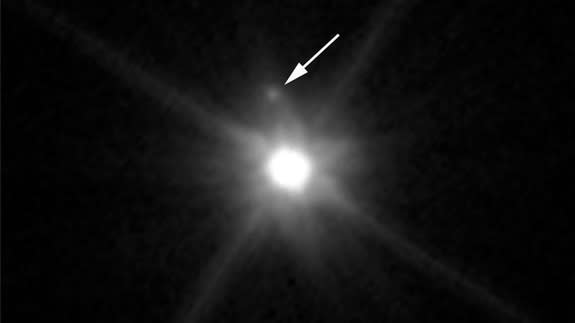Hubble telescope spots tiny moon orbiting dwarf planet Makemake

Scientists have found a previously unseen moon orbiting Makemake, a tiny dwarf planet on the outskirts of the solar system.
This marks the first time a moon has been spotted around the little world, which takes about 310 Earth years to make a full circuit of the sun.
Scientists think the moon — nicknamed MK2 — is about 100 miles in diameter, but the exact details of this mysterious natural satellite are still a mystery.
SEE ALSO: A recipe for Pluto: Everything you need to make your favorite dwarf planet
This discovery does, however, mark a big step toward understanding more about the Kuiper belt — the group of icy bodies past Neptune's orbit in the solar system.
This region of space could hold the key to unlocking some of the major mysteries regarding how the solar system formed in the first place.
At least some of the objects in Pluto's neighborhood seem to be leftovers from the dawn of the solar system.
These pristine cosmic bits left on the outskirts of the sun's influence could help show us what the solar system looked like before the major planets coalesced into what we see today.
"Makemake is in the class of rare Pluto-like objects, so finding a companion is important," said Alex Parker, the leader of the image analysis team that discovered the moon, in a statement.
"The discovery of this moon has given us an opportunity to study Makemake in far greater detail than we ever would have been able to without the companion."
Scientists now want to figure out the orbit of the moon, in part because it will tell them more about how the Makemake system formed.
For example, if MK2 is in a circular orbit that is tight against Makemake, it may mean that the system was created from a collision, much like Pluto and its largest moon, Charon.
On the other hand, if MK2 is in a wider, elongated orbit, it would potentially indicate that the moon was a passing object captured into orbit around Makemake, NASA said.
This discovery may have already helped answer a question about the dwarf planet that has been puzzling scientists for some time.

Image: NASA, ESA, and A. Parker
According to NASA, other telescopes had previously found that Makemake was extremely bright and cold, but some parts of the dwarf planet were darker and warmer than others.
Initially, scientists thought that temperature difference was most likely due to the sun warming some parts of the world more than others.
However, that hypothesis didn't quite fit because the dwarf planet's brightness doesn't change dramatically as it rotates, NASA said, something that would be expected if the dark patches were on Makemake's surface.
Now, thanks to the discovery of MK2, it seems that the darker, warmer material thought to be on the surface of Makemake was actually the surface of the moon seen by those telescopes.
MK2 is probably just a fair bit darker in color than Makemake is.
Previous observations of Makemake weren't detailed enough to spot MK2.
The high-resolution Hubble was able to pick up on the small moon using the same method scientists used to discover four of the five known moons of Pluto.
Makemake and Pluto aren't the only Kuiper belt objects that play host to moons. The dwarf planets Eris and Haumea both have moons in orbit around them as well.
For his part, Parker already wants to take a closer look at Makemake and MK2. Citing the New Horizons mission, which buzzed Pluto in July, yielding a trove of valuable data, Parker suggested sending a new probe to examine this corner of the solar system.
